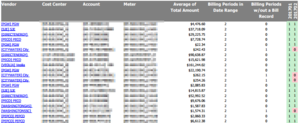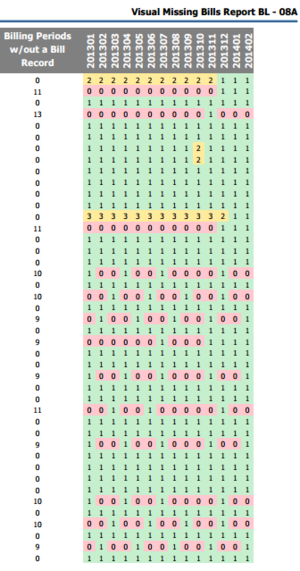|
Both Mother Nature and
many of the electric utility companies have been very kind to everyone over the
past 12-18 months. Unfortunately, it is
time to get back to reality. Mother
Nature skipped the spring season. Actually,
most of us would say we skipped winter and went from fall right into
spring. Now we are jumping right into
summer. At the same time, many of the
utility companies have had an increase in the “fuel adjustment” rates on your
electrical bills. If you have a “fuel
adjustment” charge as part of your utility rate, you are probably paying more
for your electrical usage than you were in December. Many OG&E customers started seeing the
increased rates in their February bills. OG&E customers are seeing fuel adjustment increases of 29 percent. Here at the Capitol complex we have several
facilities that have decreased electrical usage compared to last year and still
saw an increase in cost.
Facility: Attorney General Building
Usage: Decreased 8.5%
Cost: Increased 17.1%
Facility: Connors/Hodge
Complex
Usage: Decreased 8.9%
Cost: Increased 8.4%
Facility: Governor’s
Complex
Usage: Decreased 8.8%
Cost: Increased 2.7%
We have been fortunate. With the mild weather, most of us have seen a decreases in natural gas
usage. This has helped to offset the
overall utility costs. The bad news,
heating season is over. Cooling season
is upon us which means increased electrical usage at the higher rates. With the current budget situation this could
not be happening at a worse time.
What can we do? Be as efficient with your HVAC and electrical
systems as possible. This does not
necessarily mean turn everything off. In
some cases this will actually cause an increase in usage if implemented at the
wrong times. Get the message out to your
agency reminding them that it takes everyone’s efforts to be efficient. Turn off lights when not required. Unplug the phone chargers. Turn off the personal fans. Those are the types of things individual
employees can do to assist. In regards
to your facility HVAC and electrical operations, get with your maintenance
departments and discuss facility operations. If you cannot come up with some energy efficiency options, please contact
the State Energy Program office. We can assist you with these
evaluations.
Back to Top
Many organizations are
in desperate need of HVAC, electrical or lighting upgrades. The problem is having the money to pay for
the projects. OMES Construction and
Properties now has the Performance Based Efficiency Contract Program to assist
with these needs. This program is not a
new concept. Many have heard it
called and “ESCO” contract or an “Energy Efficiency” contract. This program is a public/private partnership
to assist organizations with the capital required for some of these
infrastructure projects. We believe for
many organizations, this may be the only way they will be able to upgrade
systems that are well past their useful operation.
There is no upfront
cost to have your facilities evaluated. If, after the initial evaluation, your organization is not interested in
pursuing the program at this time, the process is halted and there is no cost to
the organization.
This program could be
your organization's path to improved operations and reduced electrical
usage, possibly at no out of pocket
cost. If you would
like more information on the Performance Based Efficiency Contract Program, please contact Mike Jones or Paul Haley.
CAP Phone #:
405-521-2112
CAP Email:
CAP@omes.ok.gov
Back to Top
The
days are getting longer and we moved our clocks forward giving us more
daylight. Thanks to the extra sunlight we can now start turning off light where
not needed. The more you use natural day light, the more energy you save. This
will also extend the life of that light bulb, saving on maintenance and
replacement cost.
Back to Top
Questions?
Email 20x2020@omes.ok.gov.
Subscribe to receive updates in your email.
|
Despite what it's name suggests, the BL-08A - Visual
Missing Bills report may not be not the best report for finding gaps in
your utility bill history. It all depends on what you mean by gaps.
If you want to verify that you've received one
bill in every billing period, then BL-08A is a great color-coded
report for spotting missing bills (or unusual numbers of bills) for a large
number of accounts in just a few seconds.
Unusual Billing Activity
The BL-08A report provides a link to each included vendor in
your EnergyCAP database, along with columns for Cost Center, Account, Meter,
Average of Total Amount, Billing Periods in the Date Range (as specified by
your report date filter), Billing Periods Without a Bill Record, and the number
of bills in your EnergyCAP database for each account/meter
combination in each included billing period:

Using appropriate filters, you can run the report for
specific accounts, vendors or places, or you can run it for your entire
organization. Make sure to set the Billing Period filter to include all
relevant billing periods. Those billing periods that include a single bill will
display in green, while those missing any bill will display in red. Billing
periods with an unusual amount of billing activity (more than one bill in the
billing period) will display in yellow. This is a great way to spot
missing/suspect historical data, since you can search prior months and even
years by setting the appropriate date filters when you run the report.
Below is a graphic displaying 14 months of bill
history from the BL08A report:
 If you see accounts with no bills for a long period of time,
the account may need to be set to inactive, or you may want to add a Service
End Date.
Locating and Dealing with Gaps in Your Utility Bill
History
For a closer inspection of your utility bill history, the BL-08E Days
Not Included in Any Bill report may be just what you need. It is
similar to BL08, which finds gaps between the End Date of one
bill and the Start Date of the next bill. It also finds overlapping
billing periods.
 These types of gaps between bills may indicate
missing bills or data entry errors. When running the BL-08E, the user can
select a specific date range for locating gaps before, between or after bills.
The report will provide a record even if no bills exist for an account that is
in service. Gaps may indicate billing problems, account obsolescence or data
entry errors.
When using BL-08E to spot those smaller
gaps in data, set allowable gap days to 0 to locate every instance
of specific dates that are not included on ANY utility bill. A large gap
(perhaps 30 days) usually indicates a missing bill, whereas a small gap
(perhaps five days) usually means that a date was entered incorrectly. A
one-day gap usually means that the vendor may submit bills in a format such
that the current bill’s Start Date is the day AFTER last bill’s End Date. This
is not standard practice, since meters are seldom read at 12:00 midnight, so
this can be a problem. See the EnergyCAP Online documentation for more information on the
impact of gaps in billing data.
Back to Top |